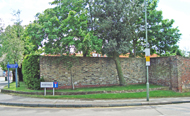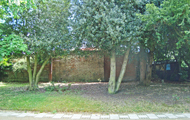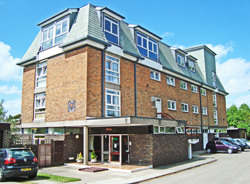Woodside Home
Baxendale, Whetstone, N20 0EH
Medical dates:
Medical character:
Long-term care
On 23rd December 1861, on the instigation of its founder, Louisa Twining
(1820-1912), the Industrial Home at No. 23 New Ormond Street (now
No. 22 Great Ormond Street) took in a few chronically ill elderly
females over the Christmas period. The patients were cared for by
the pupils of the Industrial Home, which
was run by the Workhouse Visiting Society (also established by Louisa Twining and located in the same building) to provide practical training
in domestic service and nursing care for young girls so that they could
find employment.
The women were accommodated in an unused schoolroom at the back of No. 23, which had been converted into an infirm ward with 6 beds. The first patient was a destitute old woman, who had been discharged from the Middlesex Hospital as incurably ill, and who otherwise would have had to go to the workhouse.
The Committee of the Workhouse Visiting Society decided there was a need for a home for such elderly infirm women. The premises at the Industrial Home were inadequate and the house next door, at No. 22 New Ormond Street (now No. 20 Great Ormond Street), was rented for the purpose.
The Home for the Aged and Incurable opened in 1862. Its inmates were aged mainly between 61 and 85 years.
In 1863 the house on the other side of the Industrial Home, No. 24 New Ormond Street (now No. 24 Great Omond Street), became vacant was was taken instead. The 3-storey house provided accommodation for 30 incurable patients. The three floors were named Harmony, Concord and Peace.
Just before the lease was due to expire in 1889, the home moved to a house in Whetstone, which had been donated by the late Joseph Baxendale, owner of the haulage firm Pickfords. The property, which had been built by Mr Baxendale in 1841, was described as a "beautiful villa with a pretty conservatory, in a setting of lawns, groves and a lake".
The Woodside Home for Incurables opened in 1888 as a home of rest for incurable and infirm women.
In 1891 it had 44 patients.
In 1911 it had 56 beds and, in 1926, 52 beds.
By 1931 there were 54 beds.
The Home closed for the duration of WW2, and its front room was used as a police station for the Special Constabulary. It reopened after the war but did not join the NHS in 1948.
In the late 1950s much of the land in the southwest part of the site was sold and a new purpose-built Home erected to the west of the original building. The new Home opened in 1965 with accommodation for 55 elderly men and women (preferred). It is run by Baxendale, a charitable trust, and managed through a House Committee of the Woodside Home.
Present status (May 2009)
A B&Q store occupies the entrance of the original Home, while Barnet House, an 11-storey office block owned by Barnet Council, occupies its site. A small road - Baxendale - runs through the grounds of the old Home, originally a drive leading south to the nearby St John's Church. The grounds themselves are occupied by a private housing estate.
The women were accommodated in an unused schoolroom at the back of No. 23, which had been converted into an infirm ward with 6 beds. The first patient was a destitute old woman, who had been discharged from the Middlesex Hospital as incurably ill, and who otherwise would have had to go to the workhouse.
The Committee of the Workhouse Visiting Society decided there was a need for a home for such elderly infirm women. The premises at the Industrial Home were inadequate and the house next door, at No. 22 New Ormond Street (now No. 20 Great Ormond Street), was rented for the purpose.
The Home for the Aged and Incurable opened in 1862. Its inmates were aged mainly between 61 and 85 years.
In 1863 the house on the other side of the Industrial Home, No. 24 New Ormond Street (now No. 24 Great Omond Street), became vacant was was taken instead. The 3-storey house provided accommodation for 30 incurable patients. The three floors were named Harmony, Concord and Peace.
Just before the lease was due to expire in 1889, the home moved to a house in Whetstone, which had been donated by the late Joseph Baxendale, owner of the haulage firm Pickfords. The property, which had been built by Mr Baxendale in 1841, was described as a "beautiful villa with a pretty conservatory, in a setting of lawns, groves and a lake".
The Woodside Home for Incurables opened in 1888 as a home of rest for incurable and infirm women.
In 1891 it had 44 patients.
In 1911 it had 56 beds and, in 1926, 52 beds.
By 1931 there were 54 beds.
The Home closed for the duration of WW2, and its front room was used as a police station for the Special Constabulary. It reopened after the war but did not join the NHS in 1948.
In the late 1950s much of the land in the southwest part of the site was sold and a new purpose-built Home erected to the west of the original building. The new Home opened in 1965 with accommodation for 55 elderly men and women (preferred). It is run by Baxendale, a charitable trust, and managed through a House Committee of the Woodside Home.
Present status (May 2009)
A B&Q store occupies the entrance of the original Home, while Barnet House, an 11-storey office block owned by Barnet Council, occupies its site. A small road - Baxendale - runs through the grounds of the old Home, originally a drive leading south to the nearby St John's Church. The grounds themselves are occupied by a private housing estate.

The site of the original entrance to the Home.


Signage to Woodside Home at the corner of the High Road and Baxendale (left). An old wall along Baxendale may be the original wall to the property (right).

The current Woodside Home, built in 1965.

A broken mosaic sundial on the side of the building bears the legend "Horas non numero nisi serenas" (I only count the happy hours).
Twining L 1893 Recollections of Life and Work. London, Edward Arnold.
http://alanthill.com
www.british-history.ac.uk
www.charity-commision.gov.uk (1)
www.charity-commision.gov.uk (2)
www.finchleysociey.org.uk
www.kimptonvillage.tsohost.co.uk
www.londongardensonline.org.uk
www.onourstreet.co.uk
www.ucl.ac.uk (1)
www.ucl.ac.uk (2)
www.woodsidehome.org.uk
Return to home page